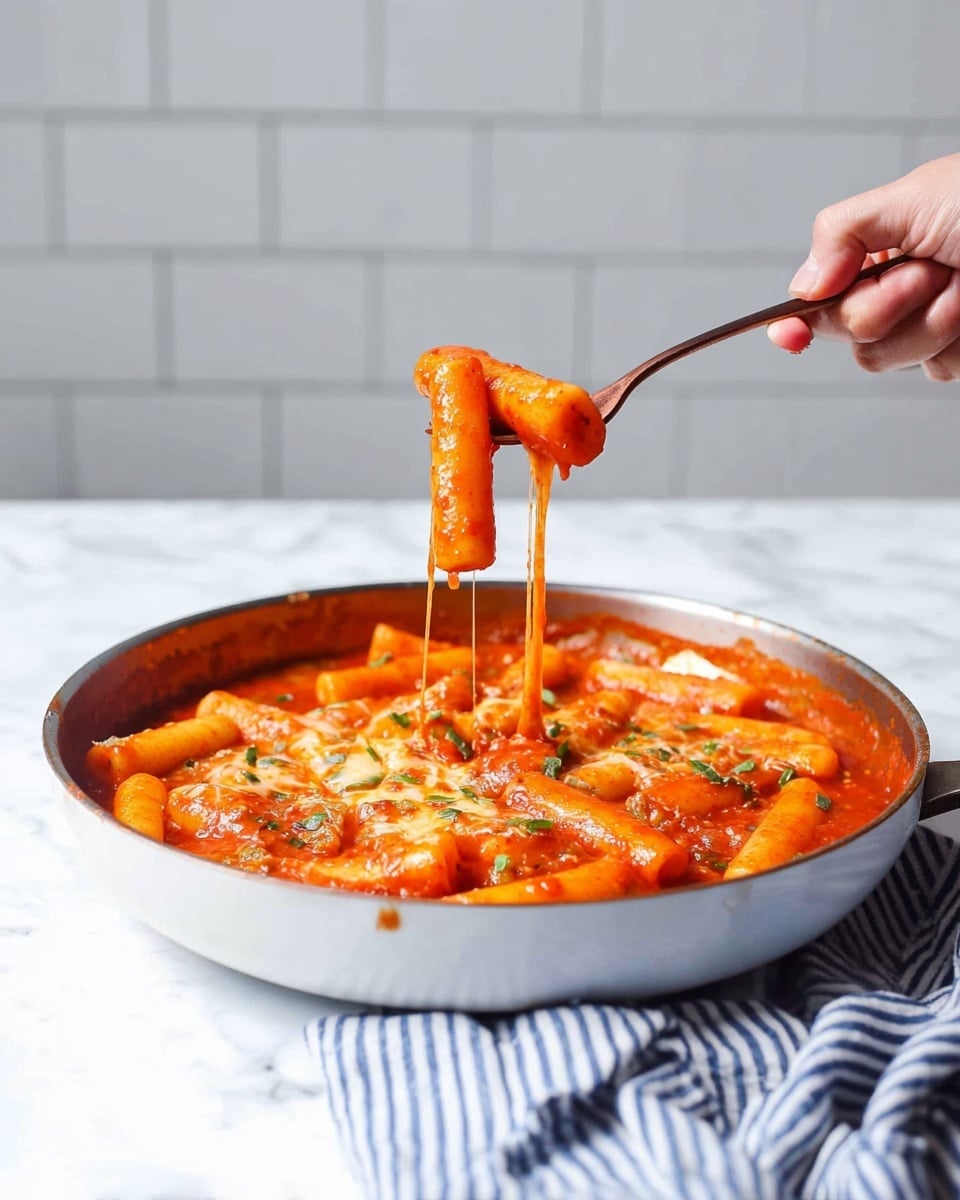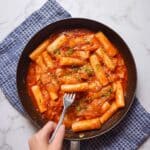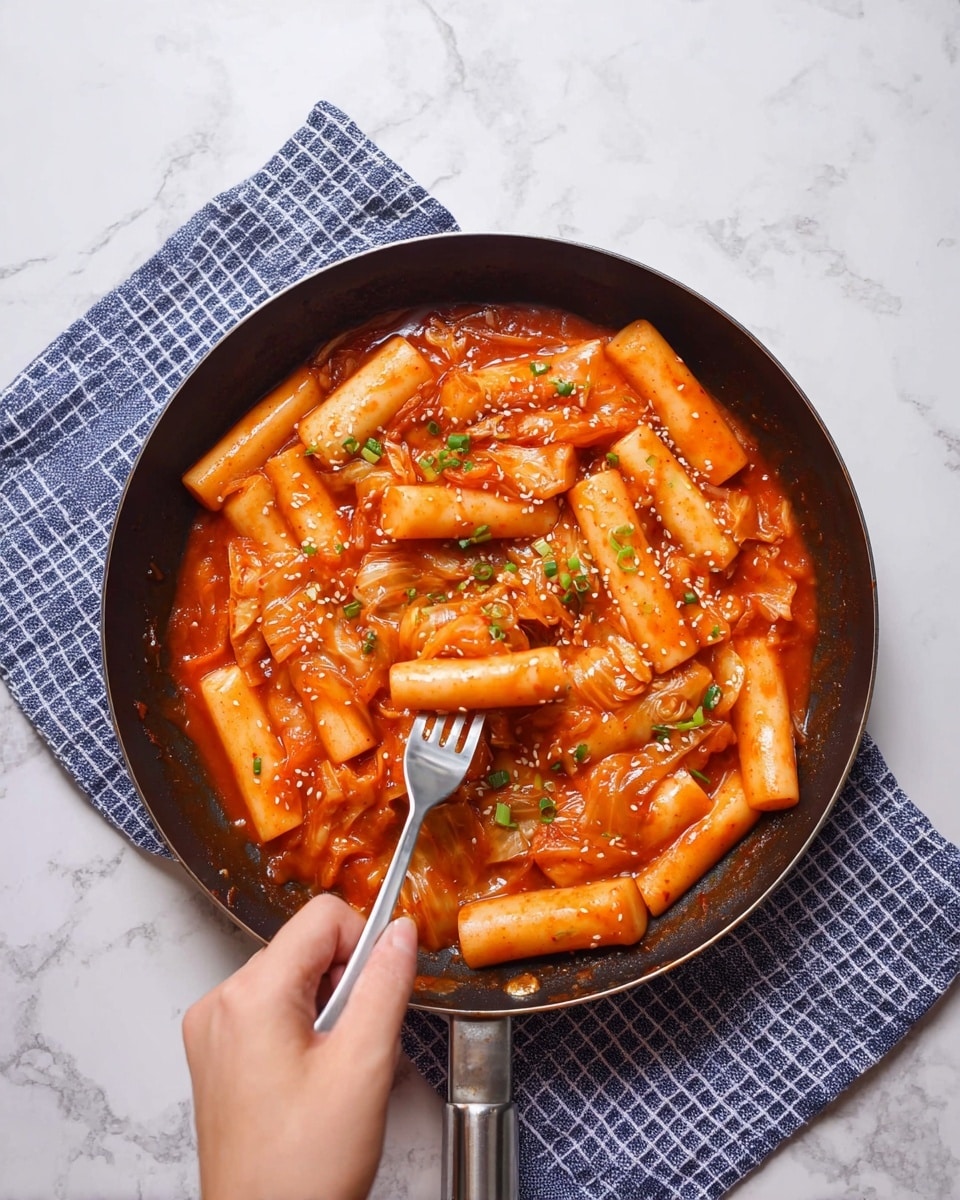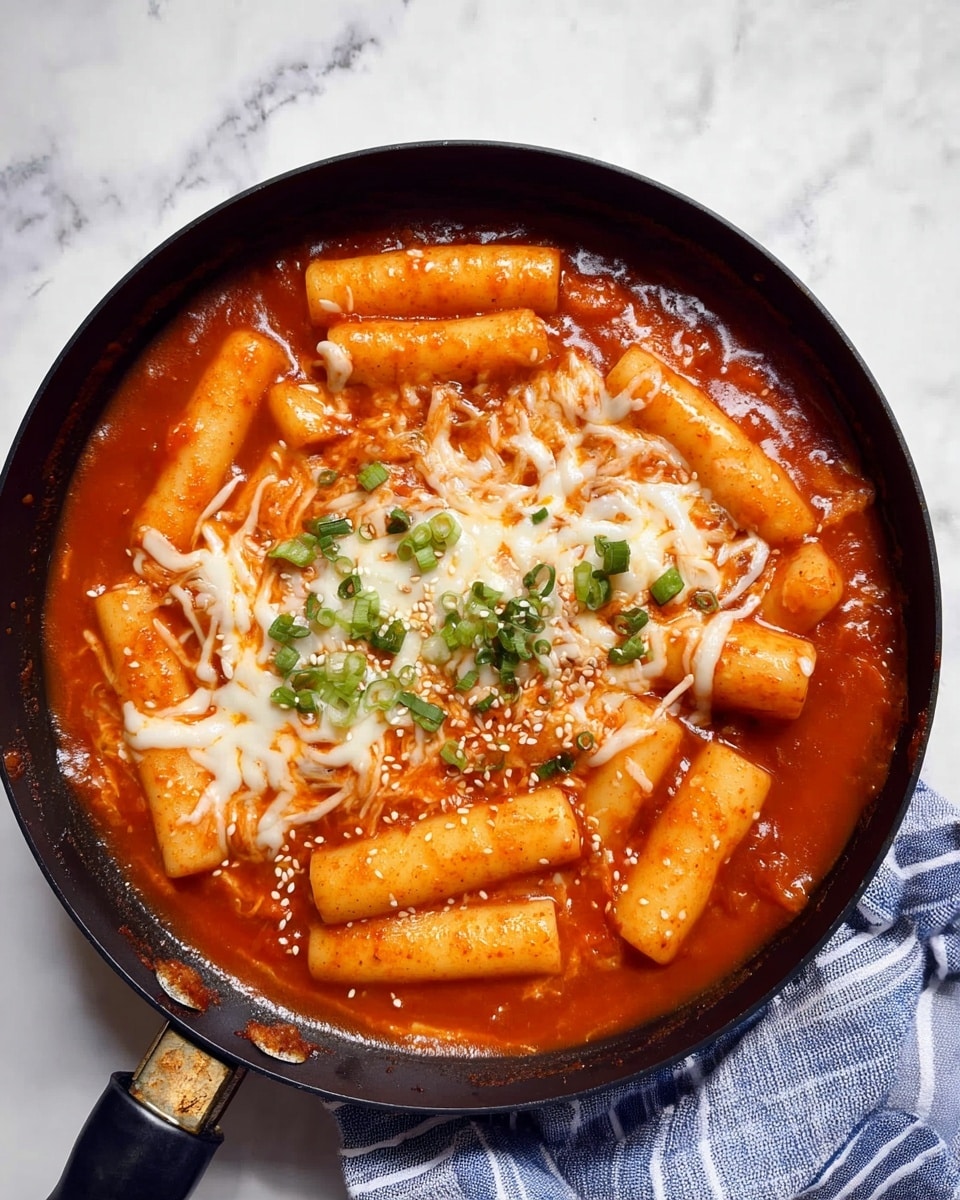If you’ve ever craved that perfect balance of spicy, chewy, and cheesy in one irresistible Korean snack, I’m about to change your life with this Cheese Tteokbokki Recipe. This dish is a total game-changer — tender rice cakes swimming in a rich, spicy sauce with gooey mozzarella melting on top. Trust me, once you try this, you’ll be hooked. Let me walk you through my favorite way to nail this at home, so you end up with that authentic, comforting goodness every time.
Why You’ll Love This Recipe
- Cheesy Comfort at Its Best: The creamy mozzarella melted over spicy tteokbokki creates a perfect flavor harmony you’ll crave again and again.
- Quick & Easy: You’ll have dinner ready in just about 20 minutes — ideal for busy weeknights or last-minute cravings.
- Customizable: Whether you want it extra spicy, with fish cakes, or loaded with veggies, this recipe is super flexible to your taste.
- Authentic Korean Flavor: It’s packed with traditional Korean ingredients like gochujang and gochugaru that truly capture that authentic tteokbokki experience.
Ingredients You’ll Need
Getting the right ingredients makes all the difference in this Cheese Tteokbokki Recipe. Here’s what you want to look for — fresh or frozen rice cakes both work, just prep accordingly. And the balance of chili paste and flakes will give your sauce its signature spicy kick.
- Korean rice cakes: Fresh ones are best if you can find them, but frozen works fine if soaked well to soften.
- Dashi or Korean soup stock: This adds depth right from the start — you can substitute with anchovy stock or a mild broth too.
- Mozzarella cheese: Freshly grated melts best; don’t skimp here if you want that gooey cheese pull.
- Gochujang (Korean chili paste): The heart of the sauce — flavorful and mildly sweet with heat.
- Gochugaru (Korean chili flakes): Adds texture and extra spice — adjust amount based on your heat tolerance.
- Granulated sugar: Balances the heat with sweetness.
- Corn syrup or extra sugar: Adds gloss and keeps the sauce thick and luscious.
- Soy sauce: For umami depth.
- Minced garlic: A little pungency amps up the flavor big time.
- Sesame oil: For that finishing fragrance and richness.
- Green onions and toasted sesame seeds (garnish): Add freshness and a nutty crunch.
Variations
I often tweak this Cheese Tteokbokki Recipe depending on what I have in the fridge or if I want to mix it up for guests. Feel free to get creative — it’s forgiving and still delicious!
- Add fish cakes: I love tossing in sliced oemuk (fish cakes) for that extra chewiness and savory flavor — my family can’t get enough.
- Hard-boiled eggs: Slice some in half and add on top. It balances the heat perfectly and makes it more filling.
- Sausages or seafood: When I want a heartier meal, sweet Korean sausages or shrimp work wonders.
- Adjusting spice level: If you’re sensitive to heat, reduce gochugaru or swap in mild chili paste varieties without losing flavor.
- Cheese types: Mozzarella is ideal, but for an extra creamy or sharp twist, try blending in cheddar or mozzarella-cheddar combo.
How to Make Cheese Tteokbokki Recipe
Step 1: Prep the Rice Cakes
If you’re using frozen rice cakes, here’s the trick — soak them in warm water for 20 to 30 minutes so they soften up nicely. Fresh rice cakes can skip this step, but I always like to check their texture before cooking so they don’t end up too dry or hard.
Step 2: Mix the Sauce
In a small bowl, stir together the gochujang, gochugaru, sugar, corn syrup (or extra sugar), soy sauce, and minced garlic until it looks like a smooth, fiery paste. This sauce is where the magic starts, and pre-mixing helps it blend evenly into the dish.
Step 3: Cook the Rice Cakes in Stock
Heat a large skillet or frying pan over medium-high heat and pour in the dashi or Korean soup stock. Add your soaked rice cakes and bring to a boil. Seeing those rice cakes get soft and plump always feels like the first real step toward deliciousness.
Step 4: Incorporate the Sauce & Thicken
Once the stock is boiling, stir in your pre-made sauce. Keep stirring occasionally as the sauce combines with the stock and thickens. This is key for getting that sticky, glossy coating that clings to every piece of rice cake.
Step 5: Add and Melt the Cheese
This is where the recipe really shines! Push the rice cakes to the center of your pan — this creates a little “nest” to hold the cheese so it doesn’t sink into the sauce. Spread a generous layer of mozzarella over the top, then cover the pan and let it melt gently on low heat until that cheese is perfectly gooey.
Step 6: Final Touches
Turn off the heat and drizzle with fragrant sesame oil. Sprinkle chopped scallions and toasted sesame seeds for that fresh, nutty finish. Now you’re ready to serve!
Pro Tips for Making Cheese Tteokbokki Recipe
- Perfect Rice Cake Texture: Don’t skip the soak for frozen rice cakes — it ensures they cook evenly and come out chewy but not tough.
- Sauce Thickness: Keep an eye on your sauce as it simmers — if it gets too thick before adding cheese, just splash a bit more stock or water to loosen it up.
- Cheese Layer Trick: Moving rice cakes to the center before melting cheese helped me get that gorgeous molten cheese layer every time without losing sauce.
- Heat Control: Melting the cheese on low heat prevents burning and uneven melting — patience is key here!
How to Serve Cheese Tteokbokki Recipe

Garnishes
I always finish mine with a drizzle of sesame oil, a handful of finely chopped scallions, and a sprinkle of toasted sesame seeds for crunch and aroma. These simple touches make the dish feel fresh and vibrant — just like at your favorite Korean spot.
Side Dishes
This Cheese Tteokbokki pairs beautifully with light sides like kimchi, pickled radish, or steamed veggies. Sometimes, I add a simple seaweed salad or cucumber kimchi to cut through the richness, balancing the meal perfectly.
Creative Ways to Present
For parties, I like serving this in a shallow cast-iron pan right at the table with extra bowls of cheese on the side. It makes the melty cheese the star, and everyone can dip and dig in together — perfect for casual sharing and fun.
Make Ahead and Storage
Storing Leftovers
Leftovers will keep well refrigerated in an airtight container for up to 2 days. I recommend storing the cheese layer separately if you can, as it tends to harden and get chewy when cold.
Freezing
I haven’t had the best luck freezing Cheese Tteokbokki because the texture of rice cakes changes, sometimes becoming a bit tough or gummy. If you do freeze it, try a quick thaw in the fridge before reheating gently on the stove.
Reheating
Reheat leftovers on the stovetop over low heat with a splash of water or stock to loosen the sauce, stirring gently to revive that saucy consistency. Add fresh cheese on top if you want to recreate that melty finish — I usually do!
FAQs
-
Can I use other types of cheese for Cheese Tteokbokki?
Absolutely! While mozzarella gives you the perfect stretch and melt, mixing in cheddar or Monterey Jack can add a sharper flavor and creaminess. Just choose cheeses that melt well to keep that gooey texture.
-
What’s the best way to soften frozen rice cakes?
Soaking frozen rice cakes in warm water for 20-30 minutes before cooking is the best way I’ve found to get them tender without losing their chewy texture. Avoid soaking in cold water, which can leave them too firm.
-
Can I make this recipe less spicy?
For a milder version, reduce the amount of gochugaru (chili flakes) or choose a mild gochujang paste. You can also add a bit more sugar or corn syrup to balance the heat overall.
-
Is there a vegetarian option?
Yes! Just use vegetable stock instead of dashi or fish-based broth and skip any fish cakes or seafood add-ins. The combination of chili paste and cheese still delivers plenty of flavor without meat.
Final Thoughts
This Cheese Tteokbokki Recipe has become one of my ultimate go-to comfort foods — perfect for those nights when you want something cozy, flavorful, and uniquely satisfying. I love sharing it with friends, and watching them light up when the cheese pulls apart is just priceless. You definitely should try it your way, tweak it, and make it part of your kitchen favorites too. I promise you’ll be coming back for seconds (and thirds!) in no time.

Cheese Tteokbokki Recipe
- Prep Time: 5 minutes
- Cook Time: 15 minutes
- Total Time: 20 minutes
- Yield: 3 servings 1x
- Category: Main Course
- Method: Stovetop
- Cuisine: Korean
Description
Cheese Tteokbokki is a popular Korean street food featuring chewy rice cakes simmered in a spicy, savory gochujang-based sauce, topped with melted mozzarella cheese for a rich and creamy twist. This recipe delivers the perfect balance of spicy, sweet, and umami flavors, enhanced with a delicious cheesy topping that makes it irresistibly comforting and indulgent.
Ingredients
Main Ingredients
- 17.5 oz (500 gr) Korean rice cakes, fresh or frozen
- 2 cups (480 ml) dashi or Korean soup stock
- 1 cup (225 gr) grated mozzarella cheese, or more
Sauce Ingredients
- 3 tbsp gochujang (Korean chili paste)
- 2 tsp gochugaru (Korean chili flakes)
- 1 tbsp granulated sugar
- 1/2 tbsp corn syrup or additional granulated sugar
- 1 tbsp soy sauce
- 2 tsp minced garlic
Garnish
- 1 tsp sesame oil
- Finely chopped scallions (green onions)
- Toasted sesame seeds
Instructions
- Soften the Rice Cakes: If you are using frozen rice cakes, submerge them in warm water for 20-30 minutes until they soften. Skip this step if using fresh rice cakes.
- Prepare the Sauce: In a small bowl, combine gochujang, gochugaru, granulated sugar, corn syrup (or extra sugar), soy sauce, and minced garlic. Mix well until the ingredients are fully incorporated.
- Cook the Rice Cakes: Heat a large frying pan or skillet over medium-high heat. Add the dashi or soup stock along with the softened rice cakes. Bring the stock to a boil, then add the prepared sauce. Stir continuously to evenly coat the rice cakes and allow the sauce to thicken, bubbling for several minutes.
- Add the Cheese: Once the sauce has thickened to your desired consistency, move the rice cakes toward the center of the pan to create a cushion for the cheese. Evenly spread the grated mozzarella cheese over the rice cakes.
- Melt the Cheese: Cover the pan with a lid and cook off heat or on low until the cheese is fully melted, creating a creamy topping.
- Garnish and Serve: Drizzle the dish with sesame oil, sprinkle with finely chopped scallions and toasted sesame seeds. Serve immediately while the cheese is warm and melted.
Notes
- You can customize your tteokbokki by adding fish cakes (oemuk), hard-boiled eggs, sausages, or seafood for additional flavor and texture.
- If using frozen rice cakes, soaking them properly is essential to achieve the best texture.
- Adjust the level of spice according to your preference by modifying the amount of gochujang and gochugaru.
Nutrition
- Serving Size: 1 serving (approx. 200 grams)
- Calories: 450 kcal
- Sugar: 8 g
- Sodium: 900 mg
- Fat: 18 g
- Saturated Fat: 9 g
- Unsaturated Fat: 7 g
- Trans Fat: 0 g
- Carbohydrates: 55 g
- Fiber: 2 g
- Protein: 14 g
- Cholesterol: 40 mg




Your email address will not be published. Required fields are marked *